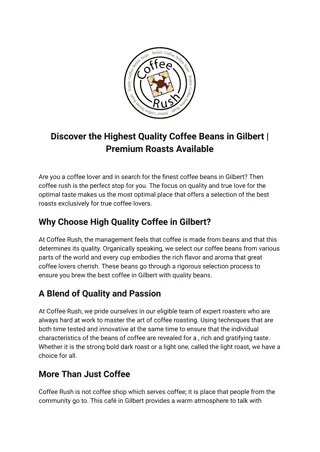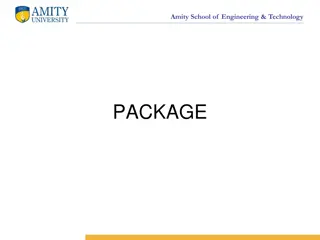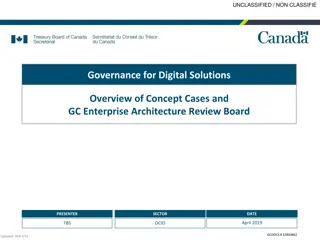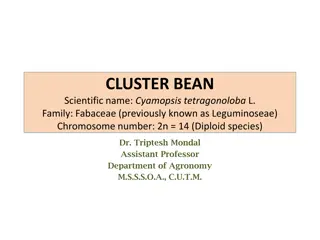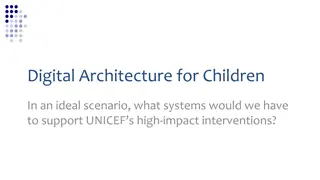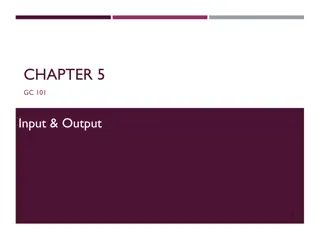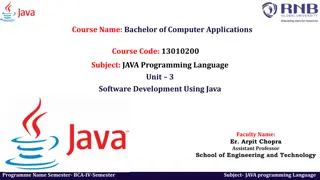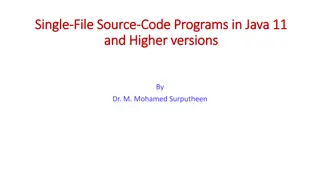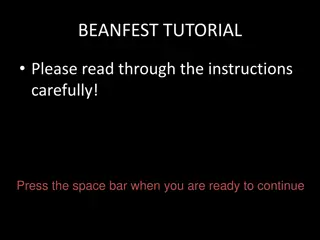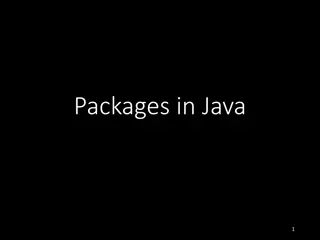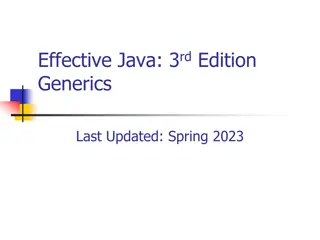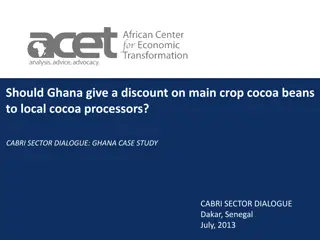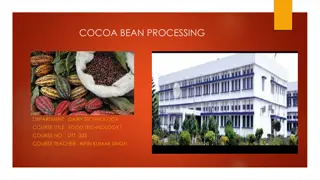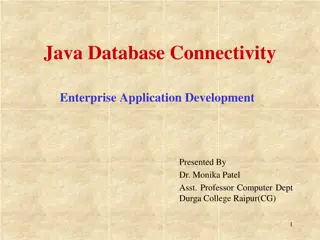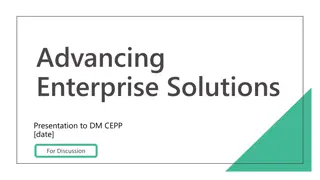Enterprise Java Beans (EJB) Architecture and Benefits
Enterprise Java Beans (EJB) serve as a pivotal development architecture for creating scalable and robust enterprise-level applications. EJB 3.0 offers simplified development compared to EJB 2.0, making it easier to build EJB-based applications. These server-side components encapsulate the business logic of an application, allowing clients to access services like inventory control. EJB containers handle technical aspects like transaction management, concurrency control, and security, enabling developers to focus solely on business logic. Various types of beans, including Session Beans, Entity Beans, and Message Driven Beans, cater to different application requirements.
Download Presentation

Please find below an Image/Link to download the presentation.
The content on the website is provided AS IS for your information and personal use only. It may not be sold, licensed, or shared on other websites without obtaining consent from the author.If you encounter any issues during the download, it is possible that the publisher has removed the file from their server.
You are allowed to download the files provided on this website for personal or commercial use, subject to the condition that they are used lawfully. All files are the property of their respective owners.
The content on the website is provided AS IS for your information and personal use only. It may not be sold, licensed, or shared on other websites without obtaining consent from the author.
E N D
Presentation Transcript
Enterprise JAVA Bean EJB is a development architecture for Building highly scalable and Robust enterprise level applications, To be deployed on J2EE compliant Application. EJB 3.0 is being a great shift from EJB 2.0 and makes development of EJB based applications quite easy. 3
What Is an Enterprise Bean? An enterprise bean is a server-side component that encapsulates the business logic of an application. The business logic is the code that fulfills the purpose of the application. In an inventory control application, for example, the enterprise beans might implement the business logic in methods called checkInventoryLevel and orderProduct. By invoking these methods, clients can access the inventory services provided by the application. 4
EJBs act as an entry point for presentation-tier technologies like Java Server Faces (JSF) but also for all external services (JMS or web services). An EJB container is a runtime environment that provides services, such as transaction management, concurrency control, pooling, and security authorization. Historically, application servers have added other features such as clustering, load balancing, and failover. EJB developers can then concentrate on implementing business logic while the container deals with all the technical plumbing. 5
Benefits Simplified development of large scale enterprise level application. Application Server/ EJB container provides most of the system level services like transaction handling, logging, load balancing, persistence mechanism, exception handling and so on. Developer has to focus only on business logic of the application. EJB container manages life cycle of ejb instances thus developer needs not to worry about when to create/delete ejb objects. 6
Types Type Session Bean Description Session bean stores data of a particular user for a single session. It can be stateful or stateless. It is less resource intensive as compared to entity beans. Session bean gets destroyed as soon as user session terminates. Entity beans represents persistent data storage. User data can be saved to database via entity beans and later on can be retrieved from the database in the entity bean. Message driven beans are used in context of JMS (Java Messaging Service). Message Driven Beans can consumes JMS messages from external entities and act accordingly. Entity Bean Message Driven Bean 7
Session Bean Stateless The session bean contains no conversational state between methods, and any instance can be used for any client. It is used to handle tasks that can be concluded with a single method call. Stateful The session bean contains conversational state, which must be retained across methods for a single user. It is useful for tasks that have to be done in several steps. Singleton A single session bean is shared between clients and supports concurrent access. The container will make sure that only one instance exists for the entire application. 8
Message-driven beans (MDBs) Is used for integrating with external systems by receiving asynchronous messages using JMS. Even though MDBs are part of the EJB specification. MDBs usually delegate the business logic to session beans 9
Services Given by the Container Remote client communication: Without writing any complex code, an EJB client (another EJB, a user interface, a batch process, etc.) can invoke methods remotely via standard protocols. Dependency injection: The container can inject several resources into an EJB (JMS destinations and factories, datasources, other EJBs, environment variables, etc.) as well as any POJO thanks to CDI. 10
Services Given by the Container State management: For stateful session beans, the container manages their state transparently. You can maintain state for a particular client, as if you were developing a desktop application. Pooling: For stateless beans and MDBs, the container creates a pool of instances that can be shared by multiple clients. Once invoked, an EJB returns to the pool to be reused instead of being destroyed. Component life cycle: The container is responsible for managing the life cycle of each component. 11
Services Given by the Container Messaging: The container allows MDBs to listen to destinations and consume messages without too much JMS plumbing. Transaction management: With declarative transaction management, an EJB can use annotations to inform the container about the transaction policy it should use. The container takes care of the commit or the rollback. Security: Class or method-level access control can be specified on EJBs to enforce user and role authorization. 12
Services Given by the Container Concurrency support: Except for singletons, where some concurrency declaration is needed, all the other types of EJB are thread-safe by nature. You can develop high-performance applications without worrying about thread issues. Interceptors: Cross-cutting concerns can be put into interceptors, which will be invoked automatically by the container. Asynchronous method invocation: Since EJB 3.1, it s now possible to have asynchronous calls without involving messaging. 13
EJBs a set of service cannot create or manage threads, access files using java.io, create a ServerSocket, load a native library, or use the AWT (Abstract Window Toolkit)or Swing APIs to interact with the user. 14
EJB Lite The specification defines a minimal subset of the full EJB API known as EJB Lite. It includes a small, powerful selection of EJB features suitable for writing portable transactional and secure business logic. Any EJB Lite application can be deployed on any Java EE product that implementsEJB 3.2. 15
Comparison Between EJB Lite and Full EJB Feature Session beans (stateless, stateful, singleton) No-interface view Local interface Interceptors Transaction support Security Embeddable API Asynchronous calls MDBs Remote interface JAX-WS web services JAX-RS web services Timer service RMI/IIOP interoperability EJB Lite Yes Yes Yes Yes Yes Yes Yes No No No No No No No Full EJB 3.2 Yes Yes Yes Yes Yes Yes Yes Yes Yes Yes Yes Yes Yes Yes 16
Writing Enterprise Java Beans @Stateless public class BookEJB { @PersistenceContext(unitName = YourName") private EntityManager em; } public Book findBookById(Long id) { return em.find(Book.class, id); } public Book createBook(Book book) { em.persist(book); return book; } 18
Anatomy of an EJB A bean class: The bean class contains the business method implementation and can implement zero or several business interfaces. The session bean must be annotated with @Stateless, @Stateful, or @Singleton depending on its type. Business interfaces: These interfaces contain the declaration of business methods that are visible to the client and implemented by the bean class. A session bean can have local interfaces, remote interfaces, or no interface at all (a no-interface view with local access only). 19
EJB - Environment Setup EJB is a framework for Java, so the very first requirement is to have JDK installed in your machine. 22
EJB - Stateless Bean A stateless session bean is a type of enterprise bean which is normally used to do independent operations. A stateless session bean as per its name does not have any associated client state, but it may preserve its instance state. EJB Container normally creates a pool of few stateless bean's objects and use these objects to process client's request. Because of pool, instance variable values are not guaranteed to be same across lookups/method calls. 26
Steps required to create a stateless EJB Create a remote/local interface exposing the business methods. This interface will be used by the EJB client application. Use @Local annotation if EJB client is in same environment where EJB session bean is to be deployed. Use @Remote annotation if EJB client is in different environment where EJB session bean is to be deployed. Create a stateless session bean implementing the above interface. Use @Stateless annotation to signify it a stateless bean. EJB Container automatically creates the relevant configurations or interfaces required by reading this annotation during deployment. 27
Remote Interface import javax.ejb.Remote; @Remote public interface LibrarySessionBeanRemote { //add business method declarations } 28
Stateless EJB @Stateless public class LibrarySessionBean implements LibrarySessionBeanRemote { //implement business method } 29
Enterprise JavaBean Architecture The Enterprise JavaBeans architecture defines a standard model for Java application servers to support Write Once, Run Anywhere (WORA) portability EJB technology takes the WORA concept to a new level. EJB completely portable across any vendor s EJB compliant application server. The EJB environment automatically maps the component to the underlying vendor-specific infrastructure services. 30
Enterprise JavaBeans The EJB architecture specifies the responsibilities and interactions among EJB entities EJB Servers EJB Containers Enterprise Beans EJB Clients Enterprise Bean Enterprise Bean EJB Container Clients Clients EJB Server 31
EJB Server Provides a Runtime Environment The EJB Server provides system services and manages resources Process and thread management System resources management Database connection pooling and caching Management API 32
EJB Container Provides a Run-time Environment for an Enterprise Bean Hosts the Enterprise JavaBeans Provides services to Enterprise JavaBeans Naming Life cycle management Persistence (state management) Transaction Management Security Likely provided by server vendor 33
Enterprise JavaBeans A specialized Java class where the real business logic lives May be developer-written or tool-generated Distributed over a network Transactional Secure Server vendors provide tools that automatically generate distribution, transaction and security behaviour Enterprise Bean Enterprise Bean EJB Container EJB Server 34
EJB Clients Client access is controlled by the container in which the enterprise Bean is deployed Clients locates an Enterprise JavaBean through Java Naming and Directory Interface (JNDI) RMI is the standard method for accessing a bean over a network 35
Whats Unique About EJB Declarative Programming Model Mandates a container model where common services are declared, not programmed At development and/or deployment time, attributes defining the bean s transaction and security characteristics are specified At deployment time, the container introspects the Enterprise JavaBean attributes for the runtime services it requires and wraps the bean with the required functionality At runtime, the container intercepts all calls to the object Provides transactional, threading and security behavior required before the method invocation Invokes the method on the object 36 Cleans up after the call
Entity Bean Represents Data Implements javax.ejb.EntityBean interface Maps a data source to a Java class table, view, join or stored procedure in a relational database a set of related records in a database legacy data Each instance of an entity bean is one row of data Each instance of an entity bean is uniquely identified by a primary key An Entity Bean can also have additional methods for business logic, etc. 37
Comparing Session and Entity Beans Session Beans Mandatory for EJB 1.0 Represents a specific client (1 instance per client) Short-lived Transient Can be any Java class May be transactional Business Logic Beans Entity Beans Optional for EJB 1.0 Represents underlying data object or context (clients share instance) Long-lived Persistent Can be a class that maps to persistent data (e.g., database) Always transactional Beans which represent data 38
EJB Persistence Provides Entity Beans the ability to store and retrieve their state Can be implemented by a bean Bean Managed Persistence Can be implemented by a container Container Managed Persistence 39
Bean Managed Persistence The entity bean is responsible for its persistent behavior EJB developer must implement database access ejbCreate( ), ejbLoad(), ejbStore(), ejbRemove() Not automated, developer manually creates mapping through JDBC calls Not as reusable Hard-code database access within class Advanced features like connection pooling and caching are difficult to support because of reliance on hand written code 40
Container Managed Persistence The EJB container is responsible for persistence The container provides tools that generate code in the EJB class that maps methods in the bean to a result set Can map to a table, view, join or stored procedure in a database Server provides automated mapping to convert relational data to bean instances Advanced features like connection pooling and caching are easily supported High reuse 41

 undefined
undefined





